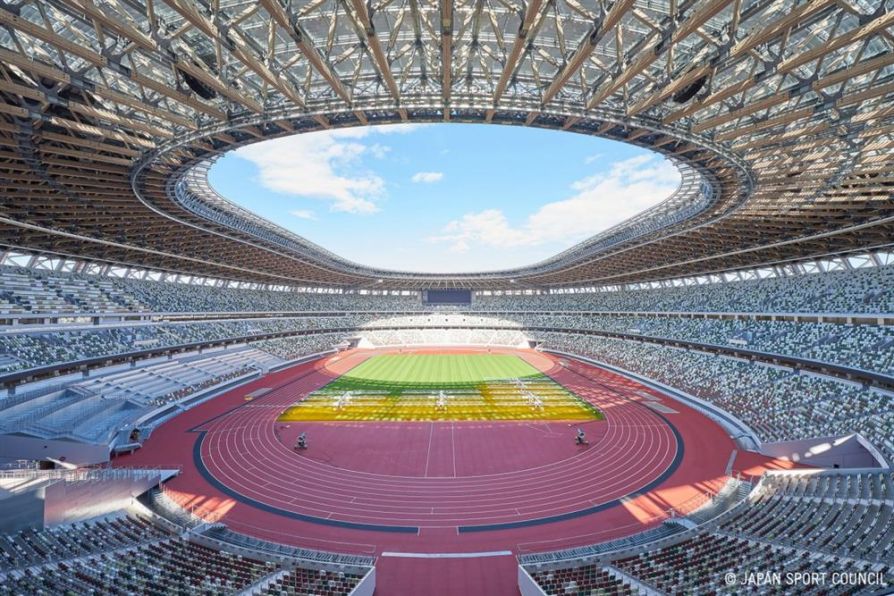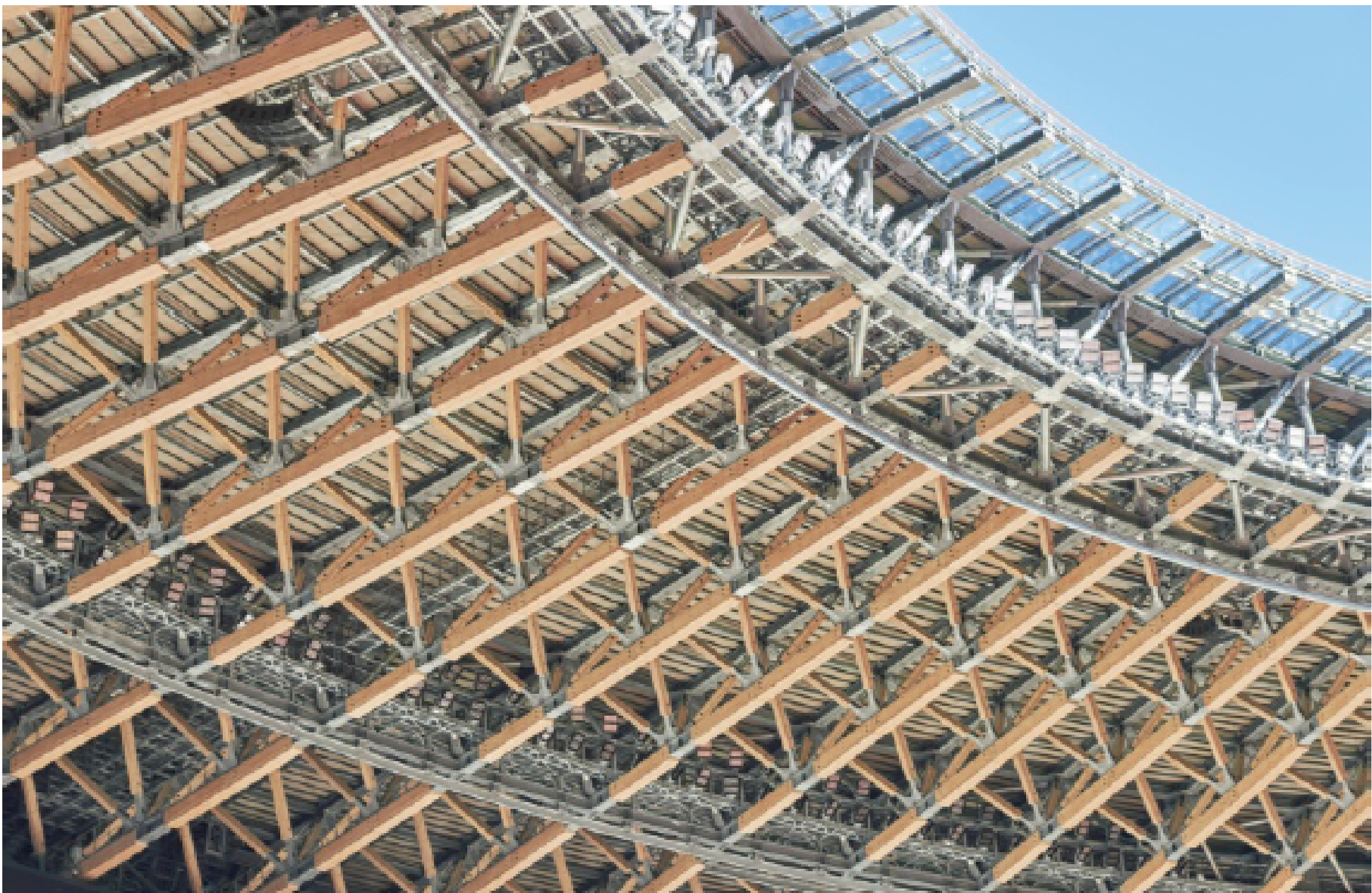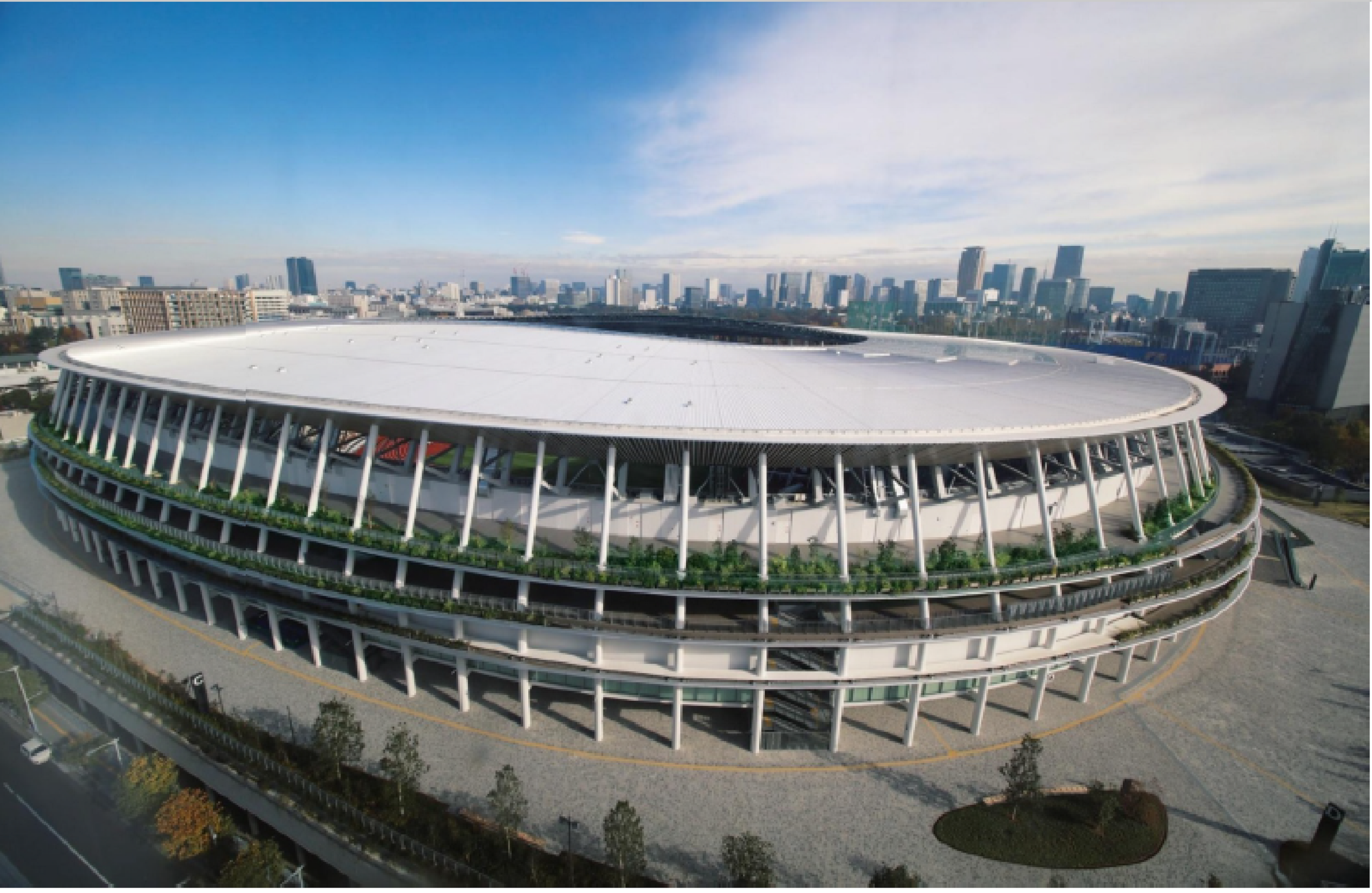Architect Kuma Kengo Shares His Thinking Behind Japan’s New National Stadium Design

Architect Kuma Kengo Shares His Thinking Behind Japan’s New National Stadium Design
Naoyuki Miyayama|Interviewer
Yumi Kiyono|Writer
JAPAN SPORT COUNCIL
|Photo Credits
― New National Stadium has finally appeared at last in Meiji Jingu Gaien, Tokyo. You, Mr. Kuma, must have been deeply moved since you took part in its design.
Kengo Kuma (hereinafter Kuma) I’m really glad to see the project finally completed after many twists and turns. The initial design proposed by Mr. Zaha Hadid caused a controversy then scrapped to start all over again. I was appointed after that, so I felt tremendous pressure at first. However, I had a luck to work with a great team and we were able to complete the project.
― Taisei Corporation, Azusa Sekkei Co.,Ltd. and Kengo Kuma & Associates had worked on the project as an integrated team to carry out design and construction. How did your team work together?
Kuma I had an opportunity to work with Taisei Corporation and Azusa Sekkei Co.,Ltd., leading construction company and design office. I felt a sense of unity among us. I expected that we might face difficulties in communication because we were all strangers to each other but had to work together on such a big project. However, each one of us suggested new techniques and ideas one after another. At the beginning of the project, I determined to devote myself to being a listener in the team and took on any reasonable ideas and suggestions from both younger and senior members. It turned out to stimulate our discussion and find the best solution at the end.
― One of the features of New National Stadium is that its heavy use of wood. Is that a trend in architectural industry?
Kuma For Nakagawa-machi Bato Hiroshige Museum of Art (Tochigi) and Great (Bamboo) Wall (Beijing, China), I integrated natural materials, such as wood and bamboo, for buildings to begin with. After 2000, I think more people in architectural industry began to be interested in using wood. Placing an importance on being eco-friendly has been one of the biggest concerns in global scale and it made us realized that using wood could contribute to reduce CO2. At the same time, the durability of wood and new technology to enhance durability had made a significant progress. Nowadays, wooden houses become trend in the world. However, there are differences in European style and Japanese style. I hope that I can spread Japanese style to the world.
― What do you mean by Japanese style?
Kuma It’s not about so-called Japanese style architecture, but about techniques to make wood last longer. The amount of rain fall per year in Japan is more than double in Europe. Under such natural features and climate of Japan, we have developed great techniques to deal with it since ancient times. For example, the Five-stories Pagoda at Horyu-ji, wooden parts in each roof can be taken out piece by piece so that it can be replaced by new one when it’s rotted. In this way, the Pagoda has been kept in its shape; one of the oldest wooden towers lasted from 7th century.
I took the idea from the Pagoda and applied it to the exterior of the stadium. The eaves are built around the stadium and its design looks like “mokoshi” in Japanese traditional architecture. Wooden parts are used in the roof. However, if it’s structured only with wood, gigantic architecture such as stadium becomes bigger. Therefore, for this stadium, we came up with the idea of hybrid structure combining steel and wood. In this way, with as much as wood used in its exterior, we were able to design the stadium to blend in with the natural greenery of Meiji Jingu Gaien.
― Your idea of wooden architecture is receiving a great attention around the world.
Kuma I designed community center, “The Exchange” in the center of Sydney’s downtown district. It was ordered by the city of Sydney in order to create a soft and warm environment for people in the district surrounded by high-rise apartments. The oval shape of the center is covered with coiled wooden wall. The center contains a childcare center, library, and open markets. It is very well received by local people with its human taste in both appearance and functions.
― It sounds like that wooden architecture has a power to change the atmosphere, doesn’t it?
Kuma You are absolutely right. We used wooden architecture for school buildings at Swiss Federal Institute of Technology in Lausanne (EPFL) in Switzerland. Since it is a technical college, there were many concrete and steel buildings on campus. However, the wooden building changed the whole atmosphere on campus. That project made me realized how much power wood could possess.
Based on my own experience, I also believe that wood has a power to attract people. People will gather at wooden buildings. It might be because the origin of humans started from forests. I think that people are able to have a peace of mind when we feel wood around us.
― So the whole world is directed toward to “wood” from a global perspective.
Kuma Besançon Art Center and Cité de la Musique, completed in 2012, in France is also wooden architecture which was the first time for me to be involved in the public architectural project in Europe. Since then, I’ve been fortunate to get more offers from France. Exhibition center “PEX Strasburg”, the project we are currently working on, is also wooden architecture. Strasbourg is rich in water and greens and known as a environmental city responded quickly to introduce LRT (light rail transit). It was a great example of how the spirit of the city to value sustainability matches with our architectural style.
― What was the turning point for architecture to shift from concrete and steel to wood?
Kuma I think Great East Japan earthquake was a major turning point. Until then, concrete buildings were recognized as symbols for durability. However, concrete buildings were damaged when exposed to the marvels of nature. In fact, it’s not an easy task to build concrete buildings last for a long time. Concrete is easily cracked and rusted by rain. Having experienced the earthquake, people are more aware of human crisis and made us recur to wood.
― Are there any techniques specifically used for New National Stadium?
Kuma The height of the stadium was kept lower in order to blend in with the natural greenery of Meiji Jingu Gaien. It was a big challenge for myself. During the period of high economic growth, making buildings higher was in trend at the time, but not now. Our team thought it over and over to make the stadium height lower, then came up with techniques to bring it down to below 50 meters from about 70 meters in Zaha’s proposal. This discovery gave all of us a power to overcome the difficult project. I still vividly remember that moment. We also used natural ventilation system together with air conditioning system. After simulations based on wind data throughout the year, the stadium was deigned to have cool wind to run through in summer and also not to be exposed to a north-wind in winter. It was a challenge that I had never worked before.
― What do you see into the future after Tokyo 2020?
Kuma When I work in powerful countries, such as China and Southeast Asia, I can see a desire for building higher and bigger. However, for me, the trend is completely moving to the opposite direction now and something compact but with high quality will pave the path. I believe Japan will be a leader of the times for this. With that idea, I sincerely hope that New National Stadium will become a symbol for a turning point of the times.

|
Roof with hybrid structure combining steel and wood blends in with the natural greenery of Meiji Jingu Gaien. |
The view from Sendagaya. The stadium uses many timbers and the top floor has about 850 meters walkway called “Grove of the Sky” at the top floor. |

|
Architect Kengo KUMA
Kengo Kuma was born in 1954. He received his Master’s degree in Architecture from the University of Tokyo where he is also currently serve as a professor. He established Kengo Kuma & Associates in 1990. Having been inspired by Kenzo Tange’s Yoyogi National Gymnasium built for the 1964 Tokyo Olympics, Kuma decided to pursue his career in architecture at a young age. He studied under Hiroshi Hara and Yoshichika Uchida at the University of Tokyo.
During his time in graduate program, he made a research trip across the Sahara to explore various villages. This experience made him realized the beauty and power of villages. After his time as a visiting scholar at Columbia University in New York, he established his office in Tokyo in 1990. Since then, his office has been designing architectural works in more than twenty countries and received prestigious awards, such as the Architectural Institute of Japan Award, the Spirit of Nature Wood Architecture Award (Finland), and the International Stone Architectural Award (Italy), to name a few.
Aiming to design architecture which merges with environmental and cultural surroundings, he proposes human scaled and gentle designs. He also constantly in search for new materials to replace concrete and steel, thus also seeking a new approach for architecture in a post-industrial society.
Writer Yumi KIYONO
Kiyono graduated from Keio University Graduate School and served as a visiting scholar at University of Cambridge. After working in a publishing company, she became a freelance journalist in 1992. She writes interviews for key persons in various fields of the times. She is a co-author of “Shin Toshi-ron Tokyo” and “Shin Mura-ron Tokyo” with Kengo Kuma.





